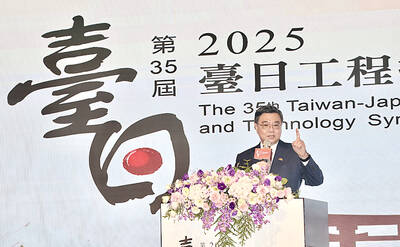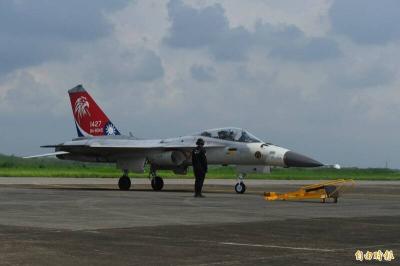An exhibition on the art of paper funeral offerings in Taiwan opened on Tuesday at the Quai Branly Museum in Paris and is to run until Oct. 27.
The exhibition, “Palace Paradis,” was organized by the museum, the Ministry of Culture’s Taiwan Cultural Center in Paris and the Kaohsiung Museum of Fine Arts.
The Paris museum is known for its collection of artifacts and art objects from non-European cultures. “Palace Paradis” is its first exhibition on Taiwan.

Photo: CNA
Burning papier-mache vehicles, houses and other objects for the deceased to use in the afterlife is part of Taiwan’s traditional funeral rites.
The paper creations on display were made by two Taipei paper studios: Hsin-Hsin and Skea, the organizers said.
The exhibition is divided into three themes: traditional offerings, including ghost houses, household goods and food; modern consumer items, such as handbags, cellphones, yachts and airplanes; and special ritual objects, such as items made for the annual Ghost Festival.

Photo: CNA
Taiwan’s paper funeral offerings first attracted the attention of the French art world when the Museum of Decorative Arts in Paris held an exhibition in 2016.
The exhibition was reportedly inspired by a trip to Taiwan by the organizer, who chanced upon villagers burning finely crafted paper offerings.
Hsin-Hsin master Chang Hsu-pei (張徐沛), 69, whose work was featured at the 2016 exhibition, said he is happy to see appreciation for votive papier-mache in France.
Chang said he had crafted ghost houses and icons of deities for the Quai Branly exhibition.
Several young people joined his workshop after seeing the 2016 exhibition, but it is too early to say if they would stay long enough to become professionals, he said.
The ghost house is a 5:1 scale model that includes appliances and furnishings, such as chairs, beds, a television, closets and wall hangings, which took him about a month to make with the help of two artisans, Chang said.
Chang’s daughter, Chang Wan-ying (張宛瑩), said that the museum had requested a smaller-than-usual model due to space limitations and to include a model helicopter inside the house, both of which presented a challenge.
Chang Wan-ying, who studied information management, joined the family business four years ago as her father’s apprentice.
“This is a painstaking job that requires patience and physical endurance; one starts by cutting bamboo into strips and making the framework [of the model],” she said.
Making paper funeral offerings also involves communicating with grieving families and hearing their stories, she said.
“A client once told me that the ghost of the deceased had visited in a dream, saying she was going to be married in the netherworld and needed a fengguan [鳳冠, phoenix tiara] to get married,” she said.
“Another family of sisters said they all had the same dream of their little brother asking for good proper clothes for his reincarnation, so they ordered a fashionable set of clothes,” she added.
Established in 2007, Skea is a specialist workshop known for its reproduction of modern papier-mache objects, said Hsiao-pi (小皮), one of the cofounders and designers.
Hsiao-pi said she was studying British literature in college when her grandfather passed away.
As the family could not find the paper offerings they wanted on the market, she decided to build a ghost house on her own for the funeral, Hsiao-pi said.
“My grandmother, who had been sad the whole time, smiled when she saw the house I made, which eventually became the impetus to founding Skea,” she said.
Skea was founded on the idea that its creations should reflect its clientele’s image of paradise and its designers should be ready to make whatever paper offerings clients demand, she said.
People could ask for the latest cellphone to keep a loved one who liked technology well updated every year, she said, adding that Skea’s services are not limited to funerals.
“There are those who give offerings on each death anniversary and people who did not have the chance to express their feelings or thoughts before their loved one passed away,” she said. “Giving paper offerings is often a therapeutic act for the living.”

LOW RISK: Most nations do not extradite people accused of political crimes, and the UN says extradition can only happen if the act is a crime in both countries, an official said China yesterday issued wanted notices for two Taiwanese influencers, accusing them of committing “separatist acts” by criticizing Beijing, amid broadening concerns over China’s state-directed transnational repression. The Quanzhou Public Security Bureau in a notice posted online said police are offering a reward of up to 25,000 yuan (US$3,523) for information that could contribute to the investigation or apprehension of pro-Taiwanese independence YouTuber Wen Tzu-yu (溫子渝),who is known as Pa Chiung (八炯) online, and rapper Chen Po-yuan (陳柏源). Wen and Chen are suspected of spreading content that supported secession from China, slandered Chinese policies that benefit Taiwanese and discrimination against Chinese spouses of

ALIGNED THINKING: Taiwan and Japan have a mutual interest in trade, culture and engineering, and can work together for stability, Cho Jung-tai said Taiwan and Japan are two like-minded countries willing to work together to form a “safety barrier” in the Indo-Pacific region, Premier Cho Jung-tai (卓榮泰) yesterday said at the opening ceremony of the 35th Taiwan-Japan Modern Engineering and Technology Symposium in Taipei. Taiwan and Japan are close geographically and closer emotionally, he added. Citing the overflowing of a barrier lake in the Mataian River (馬太鞍溪) in September, Cho said the submersible water level sensors given by Japan during the disaster helped Taiwan monitor the lake’s water levels more accurately. Japan also provided a lot of vaccines early in the outbreak of the COVID-19 pandemic,

PROMOTION: Travelers who want a free stopover must book their flights with designated travel agents, such as Lion Travel, Holiday Tours, Cola Tour and Life Tours Air Canada yesterday said it is offering Taiwanese travelers who are headed to North America free stopovers if they transit though airports in Japan and South Korea. The promotion was launched in response to a potential rise in demand for flights to North America in June and July next year, when the US, Canada and Mexico are scheduled to jointly host the FIFA World Cup, Air Canada said. Air Canada offers services to 13 of the 16 host cities of the tournament’s soccer games, including Toronto and Vancouver; Mexico City, Guadalajara and Monterrey in Mexico; Atlanta, Georgia; Boston; Dallas; Houston;

The US approved the possible sale to Taiwan of fighter jet spare and repair parts for US$330 million, the Pentagon said late yesterday, marking the first such potential transaction since US President Donald Trump took office in January. "The proposed sale will improve the recipient's capability to meet current and future threats by maintaining the operational readiness of the recipient's fleet of F-16, C-130," and other aircraft, the Pentagon said in a statement. Trump previously said that Chinese President Xi Jinping (習近平) has told him he would not invade Taiwan while the Republican leader is in office. The announcement of the possible arms